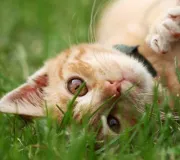Your calico cat Chelsea has personal grooming down to a science. Each morning, this five-year-old feline housemate begins licking her coat right after breakfast; and she continues all day long. Although cats regularly groom themselves, her fur is showing some bare spots. Your companion has also traded her daily playtime and brushing/belly rub sessions for this single-minded pursuit. Tomorrow, your veterinarian will determine if Chelsea has developed a potentially harmful compulsive behavior.
Feline Compulsive Behaviors
Feline compulsive behavior can take several forms. An affected cat might display obsessive grooming habits, even though her fur appears neat and tidy. She could repeatedly pace back and forth, with her treks increasing in frequency. Continued meowing and yowling can also signal a compulsive behavior. Strangest of all, you might see her suck, chew, or even eat a piece of fabric. If she chooses this route, she could become fixated on one texture, such as plush fleece blankets.
What’s Behind the Behavior
Male and female cats — from kittens to senior citizens can become victims of compulsive behavior. Although the root cause varies, stress seems to be a common factor; and indoor cats are most affected. In addition, the cat’s owner (you) influences how the behavior develops. In Chelsea’s case, you could unknowingly reinforce her actions by providing her with more food or attention if she seems distressed.
Your Vet’s Diagnosis
When your vet addresses an apparent behavioral issue, he first wants to rule out a medical problem. He’ll give Chelsea a complete physical exam. He’ll ask detailed questions about the onset of her symptoms.
Next, he’ll obtain a complete blood profile and a urinalysis. If necessary, the vet will conduct specialized tests related to specific symptoms. In Chelsea’s case, he might opt for skin scrapings and/or a skin biopsy, or tissue sample. Our Veterinary Diagnostics service can provide advanced testing and imaging to help identify any underlying health issues that may be contributing to your cat’s compulsive behavior.”
In addition to medical issues, environmental factors can also contribute to compulsive behaviors in cats. One common trigger is flying dander, which can irritate your cat’s skin and lead to excessive grooming. To learn more about how to reduce dander in your home and keep your cat comfortable, check out our article ‘Minimize Your Cat’s Flying Dander.’
Tailored Treatment Program
If your vet determines a compulsive behavior is to blame, he’ll develop a targeted treatment program. Follow his instructions regarding medication (if necessary); and change the way you respond to her antics. Finally, reduce disruptions to Chelsea’s home environment. Give her a regular schedule; providing her with food, exercise, and playtime at the same time each day.
During follow-up visits, your veterinarian will tweak Chelsea’s treatment plan based on the initial results. If your cat might display compulsive behavior symptoms, contact us for expert advice.
Contact us, your local animal clinic in St. Lucie County, FL!

